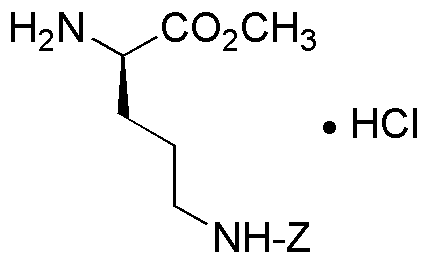Nd-Z-D-ornithine methyl ester hydrochloride is widely utilized in research focused on:
- Peptide Synthesis: This compound serves as a key building block in the synthesis of peptides, particularly in the development of therapeutic agents. Its unique structure allows for the incorporation of specific amino acid sequences that can enhance the efficacy of drugs.
- Drug Development: Researchers leverage this chemical in the design of novel pharmaceuticals, especially in the field of cancer treatment. Its ability to modify biological pathways makes it a valuable tool in creating targeted therapies.
- Biochemical Research: It is used in studies exploring metabolic pathways and enzyme functions. By understanding how this compound interacts with biological systems, scientists can gain insights into disease mechanisms.
- Diagnostics: The compound can be utilized in the development of diagnostic tools, particularly in identifying specific biomarkers related to metabolic disorders, aiding in early detection and treatment.
- Cosmetic Formulations: Its properties are also explored in the cosmetic industry for formulating anti-aging products, as it can promote skin health and improve the appearance of fine lines and wrinkles.
General Information
Properties
Safety and Regulations
Applications
Nd-Z-D-ornithine methyl ester hydrochloride is widely utilized in research focused on:
- Peptide Synthesis: This compound serves as a key building block in the synthesis of peptides, particularly in the development of therapeutic agents. Its unique structure allows for the incorporation of specific amino acid sequences that can enhance the efficacy of drugs.
- Drug Development: Researchers leverage this chemical in the design of novel pharmaceuticals, especially in the field of cancer treatment. Its ability to modify biological pathways makes it a valuable tool in creating targeted therapies.
- Biochemical Research: It is used in studies exploring metabolic pathways and enzyme functions. By understanding how this compound interacts with biological systems, scientists can gain insights into disease mechanisms.
- Diagnostics: The compound can be utilized in the development of diagnostic tools, particularly in identifying specific biomarkers related to metabolic disorders, aiding in early detection and treatment.
- Cosmetic Formulations: Its properties are also explored in the cosmetic industry for formulating anti-aging products, as it can promote skin health and improve the appearance of fine lines and wrinkles.
Documents
Safety Data Sheets (SDS)
The SDS provides comprehensive safety information on handling, storage, and disposal of the product.
Product Specification (PS)
The PS provides a comprehensive breakdown of the product’s properties, including chemical composition, physical state, purity, and storage requirements. It also details acceptable quality ranges and the product's intended applications.
Certificates of Analysis (COA)
Search for Certificates of Analysis (COA) by entering the products Lot Number. Lot and Batch Numbers can be found on a product’s label following the words ‘Lot’ or ‘Batch’.
Numéro de catalogue
Numéro de lot/série
Certificates Of Origin (COO)
This COO confirms the country where the product was manufactured, and also details the materials and components used in it and whether it is derived from natural, synthetic, or other specific sources. This certificate may be required for customs, trade, and regulatory compliance.
Numéro de catalogue
Numéro de lot/série
Safety Data Sheets (SDS)
The SDS provides comprehensive safety information on handling, storage, and disposal of the product.
DownloadProduct Specification (PS)
The PS provides a comprehensive breakdown of the product’s properties, including chemical composition, physical state, purity, and storage requirements. It also details acceptable quality ranges and the product's intended applications.
DownloadCertificates of Analysis (COA)
Search for Certificates of Analysis (COA) by entering the products Lot Number. Lot and Batch Numbers can be found on a product’s label following the words ‘Lot’ or ‘Batch’.
Numéro de catalogue
Numéro de lot/série
Certificates Of Origin (COO)
This COO confirms the country where the product was manufactured, and also details the materials and components used in it and whether it is derived from natural, synthetic, or other specific sources. This certificate may be required for customs, trade, and regulatory compliance.


